Related Research Articles

Poultry are domesticated birds kept by humans for their eggs, their meat or their feathers. These birds are most typically members of the superorder Galloanserae (fowl), especially the order Galliformes. The term also includes birds that are killed for their meat, such as the young of pigeons but does not include similar wild birds hunted for sport or food and known as game. The word "poultry" comes from the French/Norman word poule, itself derived from the Latin word pullus, which means small animal.

The chicken, a subspecies of the red junglefowl, is a type of domesticated fowl. Rooster or cock is a term for an adult male bird. A younger male may be called a cockerel; a male that has been castrated is a capon. The adult female bird is called a hen. Originally raised for cockfighting or for special ceremonies, chickens were not kept for food until the Hellenistic period. Humans now keep chickens primarily as a source of food and, less commonly, as pets.

Debeaking, beak trimming, or beak conditioning is the partial removal of the beak of poultry, especially layer hens and turkeys although it may also be performed on quail and ducks. Most commonly, the beak is shortened permanently, although regrowth can occur. The trimmed lower beak is somewhat longer than the upper beak. A similar but separate practice, usually performed by an avian veterinarian or an experienced birdkeeper, involves clipping, filing or sanding the beaks of captive birds for health purposes – in order to correct or temporarily alleviate overgrowths or deformities and better allow the bird to go about its normal feeding and preening activities. Amongst raptor keepers, this practice is commonly known as "coping".

The domestic turkey is a large fowl, one of the two species in the genus Meleagris and the same species as the wild turkey. Although turkey domestication was thought to have occurred in central Mesoamerica at least 2,000 years ago, recent research suggests a possible second domestication event in the southwestern United States between 200 BC and AD 500. However, all of the main domestic turkey varieties today descend from the turkey raised in central Mexico that was subsequently imported into Europe by the Spanish in the 16th century.

The Araucana is a breed of domestic chicken from Chile. Its name derives from the Araucanía region of Chile where it is believed to have originated. It lays blue-shelled eggs, one of very few breeds that do so.
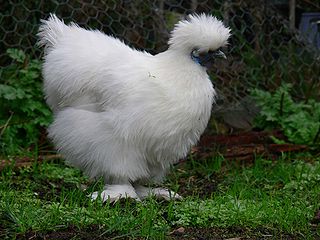
The Silkie is a breed of chicken named for its atypically fluffy plumage, which is said to feel like silk and satin. The breed has several other unusual qualities, such as black skin and bones, blue earlobes, and five toes on each foot, whereas most chickens only have four. They are often exhibited in poultry shows, and appear in various colors. In addition to their distinctive physical characteristics, Silkies are well known for their calm, friendly temperament. It is among the most docile of poultry. Hens are also exceptionally broody, and care for young well. Though they are fair layers themselves, laying only about three eggs a week, they are commonly used to hatch eggs from other breeds and bird species due to their broody nature.

Domestic geese are domesticated grey geese that are kept by humans as poultry for their meat, eggs and down feathers since ancient times. Approximately 700 million geese are slaughtered each year for meat worldwide.
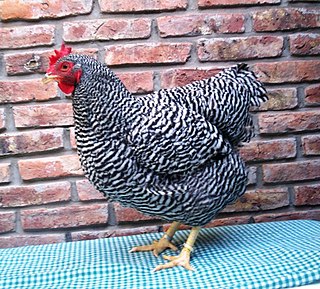
The Plymouth Rock is an American breed of domestic chicken. It was first seen in Massachusetts in the nineteenth century, and for much of the early twentieth century was the most popular chicken breed in the United States. It is a dual-purpose breed, raised both for its meat and for its brown eggs. It is resistant to cold, easy to manage, and a good sitter.
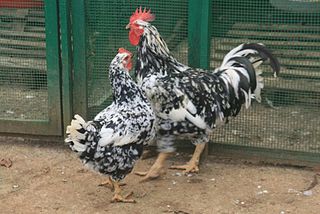
The Pita Pinta Asturiana is the only breed of chicken indigenous to the principality of Asturias, in north-western Spain.

The Campbell is a British breed of domestic duck. It was developed at Uley, in Gloucestershire, England, at the turn of the 20th century; being introduced to the public in 1898 and the Khaki variety in 1901.
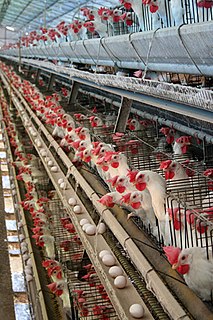
Poultry farming is the form of animal husbandry which raises domesticated birds such as chickens, ducks, turkeys and geese to produce meat or eggs for food. It has originated from the agricultural era. Poultry – mostly chickens – are farmed in great numbers. More than 60 billion chickens are killed for consumption annually. Chickens raised for eggs are known as layers, while chickens raised for meat are called broilers.
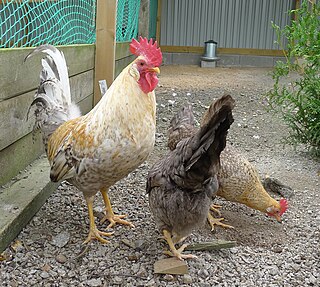
The Jærhøns or Norske Jærhøns is the only indigenous breed of domestic chicken in Norway. It is named for the traditional district of Jæren in the county of Rogaland.

The Campine is a breed of domestic chicken originating in the northern part of Belgium. It is named for the Campine region of north-eastern Belgium and south-eastern Netherlands. It was known there as the Kempisch Hoen.

The Crèvecœur is an endangered historic breed of crested chicken from the Pays d'Auge, in the Calvados département of Normandy, in north-western France. It is named after the commune of Crèvecœur-en-Auge. It is related to the La Flèche and to other Norman breeds such as the Caumont and Caux and the extinct Pavilly; the Merlerault was formerly considered a sub-type of the Crèvecœur.
The Ixworth is an English breed of white domestic chicken. It is named for the village of Ixworth in Suffolk, where it was created in 1932. It was bred as fast-growing high-quality meat breed with reasonable laying abilities.
Keeping chickens is becoming increasingly popular in urban and suburban areas. The reasons for keeping chickens are as pets, for eggs, for meat, or for eating pests. Some people will sell the eggs for side income.
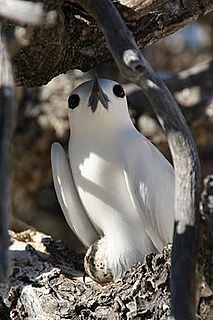
Broodiness is the action or behavioral tendency to sit on a clutch of eggs to incubate them, often requiring the non-expression of many other behaviors including feeding and drinking. Being broody has been defined as "Being in a state of readiness to brood eggs that is characterized by cessation of laying and by marked changes in behavior and physiology". Broody birds often pluck feathers from their chest and abdomen, using them to cover the eggs. As a consequence of this, they develop one or several patches of bare skin on the ventral surface. These reddish, well-vascularized areas of skin are usually called brood patches, and improve heat transfer to the eggs. Broodiness is usually associated with female birds, although males of some bird species become broody and some non-avian animals also show broodiness.

The Green-legged Partridge is an old breed of chicken indigenous to Poland. It is characterised by the unusual reseda green colour of the shanks.

The Ayam Kampong or Ayam Kampung is the chicken breed reported from Indonesia. The name means simply "free-range chicken" or literally "village chicken". In Indonesia, the term ayam kampung refer to indigenous chickens that are raised using traditional free range production techniques by almost every household in the village. It is a diverse population which resulted from the uncontrolled cross-breeding of red jungle-fowl, indigenous Southeast Asian chickens and exotic chickens of various types imported in the late 1800s by European, mainly Dutch and British, settlers.
References
- 1 2 M. L. Soares, J. C. Lopes, N. V. Brito, J. Carvalheira (2011). Characterization of growth and egg production of two Portuguese autochthonous chicken breeds: Preta Lusitânica and Amarela Archived 14 August 2014 at the Wayback Machine . Conference paper, 62nd Annual Meeting of the European Association for Animal Production, Stavanger, Norway, 29 August to 2 September 2011.
- ↑ Breed data sheet: Amarela/Portugal. Domestic Animal Diversity Information System of the Food and Agriculture Organization of the United Nations. Accessed August 2014.